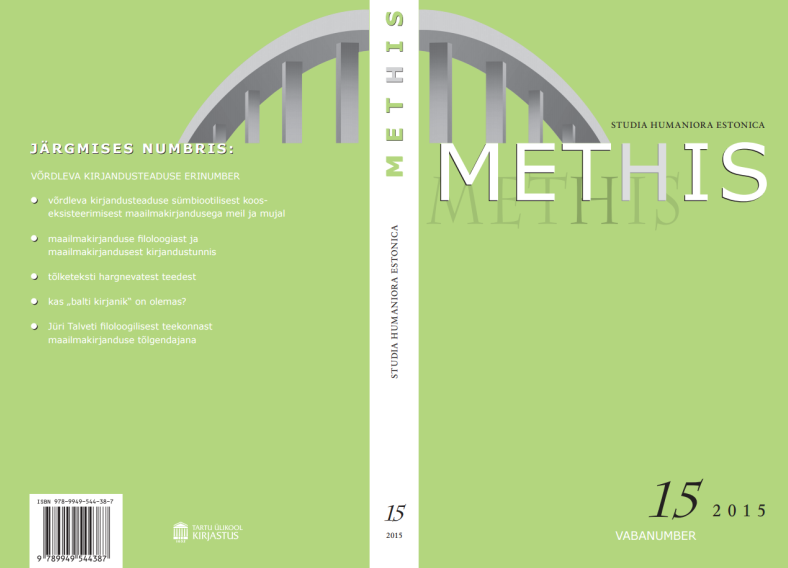Eesti Vabariigi sümboolne kapital ja suuline tõlge aastatel 1918–1940 / Oral Interpreting in the Diplomatic Communication of the Estonian Republic 1918-1940
DOI:
https://doi.org/10.7592/methis.v12i15.12115Keywords:
diplomaadid, Eesti, Pierre Bourdieu, suuline tõlge, sümboolne kapital, interpreting, diplomats, symbolic capital, Republic of EstoniaAbstract
Teesid: Artikli eesmärk on avardada teadmisi suulise tõlke ja tõlkide osatähtsusest Eesti Vabariigi loomise algaastatest kuni iseseisvuse katkemiseni 1940. aastal. Perioodil, kui Eesti Vabariik otsis tunnustust, et olla aktsepteeritud iseseisva noore riigina maailmapoliitikas, oli diplomaatilise tõlke roll ja tõlgi vastutus väga oluline. Aastate 1918–1940 kohta on analüüsitud 41 mälestusteraamatut, lisaks suulist tõlget käsitlevaid ajaleheartikleid, Eesti Rahvusarhiivi materjale diplomaatilise kirjavahetuse kohta ja Venemaaga peetud rahuläbirääkimiste protokolle aastatest 1919–1920. Analüüsi on kaasatud Pierre Bourdieu mõiste sümboolne kapital, diplomaatilist tõlget käsitletakse kui mõjufaktorit riigi sümboolse kapitali akumuleerimisel.
SU M M A R Y
Diplomatic interpreting in Estonia emerged concurrently with the proclamation of independence of the Republic of Estonia. The author of this article examined authentic material in relevant Estonian archives, museums, including newspaper articles, and memoirs, enabling her to follow the timeline of this evolution of interpreting from 1918 to 1940, as well as to locate events, languages interpreted, and attitudes vis-à-vis interpreters.
Between the two World Wars, diplomatic interpreting in Estonia was carried out by diplomats themselves, acting as interpreters. As early as September 1919, in preparation for the beginning of the Tartu Peace negotiations with Russia, the state language of the Republic of Estonia (Estonian) was used together with interpreters. French sociologist Pierre Bourdieu has argued that the state can „reap symbolic benefits“ by speaking „with distinction and thereby distinguish[ing itself] from all those who are less well endowed with linguistic capital“ (Bourdieu 1997: 21). The use of Estonian was directly linked to the prestige of the state language and to sending a message that contributed explicitly to the growth of the state’s symbolic capital. It also presupposed the subsequent use of interpreters throughout the period under review.
The Foreign Ministry was established on 14 November 1918. Of the first three officials, two were designated as interpreters (tõlk). From 1918 to 1940, the Foreign Ministry and legations had 34 officials on the staff list whose job description included the word tõlk (interpreter). No job description mentions the word tõlkija (translator), as no terminological difference was made between tõlk and tõlkija. In the inter-war period neither the ministerial officials nor diplomats had had any professional interpreter training.
To the author’s knowledge, this article is the first to associate diplomatic interpreting in Estonia with the creation of symbolic capital for the state. Symbolic capital is one of the key concepts Bourdieu introduced. By applying this concept to research on diplomatic interpreting in Estonia, we can identify a new aspect of the value of interpreters. Bourdieu stresses that political acts may enhance the symbolic capital of a state „with only their faces, their names and their honor“ (Bourdieu 1992: 119). A diplomatic interpreter is at the centre of historic events not as a passive mediator but as an active agent with a responsibility to communicate legitimate views and actions unambiguously. Diplomatic interpreters, in the sense meant by Bourdieu, enjoyed a privilege, because their acts contributed to symbolic capital and because of their association with those who laid the foundation for Estonia’s symbolic capital.


